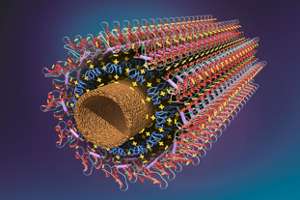 A carbon nanotube. Image courtesy of Pacific Northwest National Laboratory.
A carbon nanotube. Image courtesy of Pacific Northwest National Laboratory.
So many advances in renewable energy and transportation depend on battery technology that doesn’t yet exist. We need batteries with a high energy density that are lightweight and cheap for the widespread use of the energy of the sun when it is not shining, and the energy of the wind when it is not blowing. We need better battery technology to make hybrid and electric cars and trucks cheaper to make and cheaper to run than gasoline cars and trucks.
A battery the size, weight, and cost of a piece of paper would be ideal. This isn’t something out of the Jetsons. Today, with nanotechnology, scientists create super lightweight and super conducting tubes and wires using single atoms as the basic building blocks. Scientists at Stanford University are learning how to coat ordinary paper with an ink composed of carbon nanotubes and silver nanowires to make an excellent energy storage device.
Yi Cui, assistant professor of materials science and engineering, is leading the research team that is creating the new batteries in the laboratory. The team has put the paper and ink batteries—quite literally—to the acid test. You can crumple the paper, or dip it in an acidic fluid, and it will still work. Dr. Cui and his colleagues published a report, “Highly Conductive Paper for Energy Storage Devices," in the online Proceedings of the National Academy of Sciences.
The paper and ink storage devices, both as batteries or capacitors, may become the ideal energy storage medium for automobiles. Capacitors, which charge and release energy much more quickly than batteries, may be a better fit for automobiles, since car batteries charge and discharge quickly, compared to other energy storage devices. The lightweight, inexpensive, and energy dense batteries may be ideal for use in the electricity grid, to store energy when it is cheap and abundant and deliver it when it is expensive and hard to come by. And, since you can fold the ink and paper battery and it will still work—the self-powered paper airplane is a real possibility. We just need to get the mechanical engineers to come up with some lightweight flappers.
